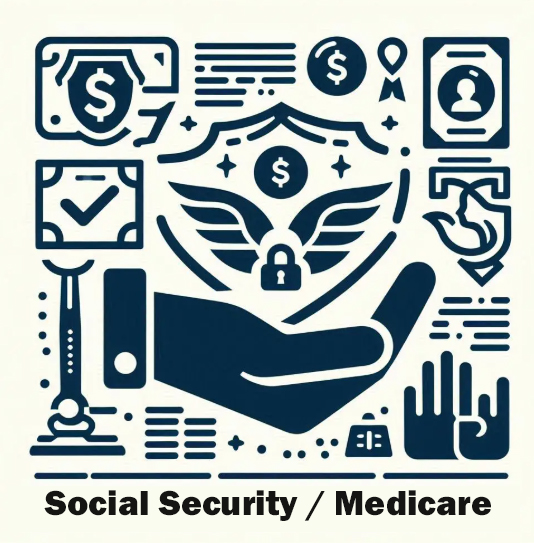Social Security and Medicare

We believe: Social Security and Medicare are vital programs for Senior Citizens.
We support:
Ensure Long-Term Solvency
🎯 Objective:
Stabilize Social Security and Medicare trust funds without cutting benefits for working families.
✅ Key Actions:
-
Lift the Payroll Tax Cap: Apply Social Security payroll taxes to all earnings to increase funding without affecting middle-income earners.
-
Create a Medicare Wealth Contribution: Introduce a modest surtax on unearned income (e.g., capital gains) for those earning over $400,000.
-
Gradual Payroll Tax Increase: Raise the combined payroll tax rate from 12.4% to 13.2% over 10 years to spread the impact evenly.
- Close Loopholes: Eliminate tax avoidance strategies used by high earners (e.g., S-corp loophole that avoids Medicare taxes).
📘 Expand and Protect Benefits
🎯 Objective:
Preserve core promises while improving the quality of life for beneficiaries.
✅ Key Actions:
-
Increase Minimum Benefits: Guarantee that long-term low-wage workers receive benefits above the federal poverty line.
-
Annual COLA Reform: Tie cost-of-living adjustments (COLAs) to the Consumer Price Index for the Elderly (CPI-E) to better reflect actual senior expenses.
-
Medicare Vision, Hearing, and Dental Coverage: Mandate these essential services under all Medicare plans.
-
Out-of-Pocket Medicare Cap: Establish an annual maximum out-of-pocket limit for Original Medicare (Part A & B), not just Medicare Advantage.
-
End the Two-Year Disability Waiting Period: Eliminate the wait for Medicare coverage for those who qualify via Social Security Disability Insurance (SSDI).
📘 Improve Administrative Efficiency and Equity
🎯 Objective:
Modernize operations to improve access, reduce waste, and deliver better service.
✅ Key Actions:
-
Fund SSA and Medicare Administration Properly: Reverse years of budget cuts and expand staffing to reduce wait times and claim processing delays.
-
Simplify Enrollment and Billing: Integrate Medicare Part A, B, and D into one unified plan with clear options and support tools.
-
Equitable Access Initiative: Target outreach and support to rural, minority, and underserved communities to boost enrollment and awareness.
-
Audit and Fraud Prevention Systems: Use AI tools to detect fraud in billing and benefit payments while minimizing false flags.
-
Digital Upgrade Plan: Fully modernize SSA and CMS digital systems for mobile access, e-signatures, and user-friendly application tools.
📘 Lower Health Care Costs for Medicare
🎯 Objective:
Reduce Medicare’s long-term costs through smarter health care policy not benefit cuts.
✅ Key Actions:
-
Drug Price Negotiation: Expand Medicare’s authority to negotiate prescription drug prices across all major medications, not just a few.
-
Support Generics and Biosimilars: Provide incentives and fast-track approval for affordable alternatives to name-brand drugs.
-
Promote Preventive Care and Telehealth: Reward providers for outcomes, not procedures, and expand coverage for chronic disease management via telemedicine.
-
Medicare Advantage Oversight: Increase transparency and regulation of Medicare Advantage plans to prevent over-billing and care denial.
-
Reduce Administrative Overhead: Standardize documentation and billing to reduce wasteful spending by hospitals and insurers.
📘 Strengthen Public Trust and Future-Proof the System
🎯 Objective:
Maintain confidence in Social Security and Medicare as universal, dependable programs.
✅ Key Actions:
-
Public Education Campaign: Launch national messaging to reaffirm the value of Social Security and Medicare for all generations.
-
Younger Worker Outreach: Improve benefit literacy and encourage early planning via digital tools and employer partnerships.
-
Intergenerational Stability Pledge: Make no cuts to earned benefits while ensuring the system’s solvency for future retirees.
-
Bipartisan Solvency Commission: Convene a commission (similar to 1983’s Greenspan Commission) to guide periodic reform with public input.
-
Constitutional Protection Option: Explore long-term legal protections for earned benefits against political misuse or privatization efforts.
TAKE ACTION – Contact Congress
(How to contact Congress) click here
Congressional Committees That Oversee Social Security and Medicare
U.S. Senate
Senate Committee on Finance
The main Senate committee responsible for Social Security and Medicare policy.
-
Jurisdiction includes:
-
Social Security benefits and taxes
-
Medicare coverage, payments, and trust funds
-
Oversight of the Centers for Medicare & Medicaid Services (CMS)
-
House Committee on Ways and Means
Primary committee for Social Security and Medicare legislation.
-
Jurisdiction includes:
-
Social Security (OASDI) – retirement, disability, and survivors benefits
-
Medicare (Parts A, B, C, D)
-
Related payroll taxes and trust funds
-
Key Subcommittees:
-
Subcommittee on Social Security – handles all matters related to the Social Security system.
-
Subcommittee on Health – oversees Medicare, especially policy related to health care delivery and financing.
Additional Oversight and Budget Committees (House and Senate)
While not primary policy-making bodies, these committees play supporting roles:
Senate Special Committee on Aging
-
Advisory role, no legislative authority.
-
Investigates issues related to aging, including Social Security and Medicare access, fraud, and quality of care.
House and Senate Budget Committees
-
Establish budgetary priorities for entitlement spending, including long-term projections for the solvency of Social Security and Medicare.
House Committee on Energy and Commerce
-
Shares jurisdiction over parts of Medicare (especially Medicare Part B and Medicaid) through its Health Subcommittee.